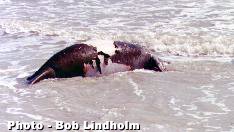ECONOMIC:
ENVIRONMENTAL:
- No 1 killer of manatees
- 107 Dolphins dead in 2004 alone
- Destroys millions of fish annually
HEALTH RAMIFICATIONS:
- Respiratory
- Skin irritations
- Seafood
QUALITY OF LIFE:
- Impacts beach quality
- Impacts fishing
- Impacts swimming
|
|
|
|
|
Effects of Black Tide and Red Tide |
 |
How bad is it? Black tide being caused by the BP oil spill, along with red tides caused by the organism Karenia brevis (K.brevis) release harmful toxins causing mass mortalities of various marine organisms. These Harmful Algae Blooms, or HABīs, are responsible for the deaths of several endangered marine mammals: the Florida manatee, for one. Already hundred's of marine animals have been killed by the oil spill and there is no way to estimate how many more will die in the coming years due to this environmental catastrophe. | |
|
|
|
|
|
Over the last 20 years, red tides caused by a number of toxic dinoflagellates, have increased in frequency and severity. Formerly, the threat was to a few regions in scattered locations. Now, it affects larger areas, in virtually every U.S. coastal state and shoreline throughout the world. Often, more than one harmful or toxic algal species is involved. Red tides affect humans, wildlife, fishery resources and our economy. |
 | |
|
|
|
|
Their dominant mode of reproduction is asexual cell division-one cell divides into two cells, those two split into four, and so on. Given the right conditions, the population size will rapidly rise. For a population to expand quickly and sustain itself over time requires the confluence of a number of factors that, to date, are not fully understood.
|
|
|
|
|
|
|
Reports detailing the economic impact of a K.brevis bloom are unavailable. However, estimates published in the early 1970īs stated that an average bloom lasting 3-4 months resulted in losses approximating $20 million to the State of Florida. The 1995-96 red tide problem cost Florida at least double that amount.
HABīs have a significant economic impact, not only from the loss of fish and shellfish, but also due to the inability of individuals to use and enjoy the coastal areas and their resources. Boating and fishing are greatly affected.
The spottiness of the geographic extent of a red tide bloom often results in news reports that "tar" areas well away from affected areas. Adverse effects on seafood markets and restaurants arise as a result of groundless public concern over the safety of eating seafood Resorts and hotels experience numerous cancellations. even during times when their beaches and waterfront are not affected.
Charter boat operators also experience numerous cancellations, even when their fishing grounds are unaffected.
|
|
|
|
|
|
|
Eating clams, mussels, oysters or scallops contaminated by red tide can cause severe illness and even death to humans. The state closes shellfish beds quickly and will not reopen them until bioassays show the shellfish are safe to eat. Federal regulations now require toxin monitoring programs that are implemented during red tide outbreaks. While some illnesses related to shellfish consumption occur, the highly cautionary regulations have been quite effective.
Aerosols from red tides can produce respiratory ailments. However, no studies have been done to determine if there are long-term consequences from inhaling potent neurotoxins from algae. Also, it is difficult to assess effects of exposure among tourists. |
|
|
|
|
|